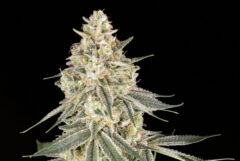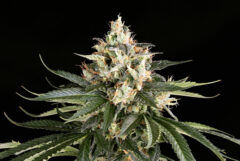In a world of rapidly changing climate and depleting resources, the need to rethink our long-term strategies and develop locally-based, sustainable industries has never before been greater. Cannabis and hemp are at the cutting edge of new, green industries, but there are plenty of changes still to be made if we wish to restore balance.
We are currently experiencing the beginning of the Anthropocene epoch, a direct result of human activity since the dawn of the Industrial Revolution. Our modern methods of conducting agriculture, trade and industry are pushing our planet to the brink, and could potentially even lead to a future in which the Earth is no longer able to support life.
As an emerging industry that has been lauded for its environmental potential, and as one that also has the power to become so vast and to positively influence so many aspects of everyday life, it is absolutely vital that the cannabis industry maintains the highest benchmarks. Cannabis is part of a dramatic socioeconomic paradigm shift, and if we do it right, we can effectively change the world.
So what must we do? The solution is really quite simple – we must keep the industry diverse, small-scale, non-invasive, and locally-based.
Keeping the Cannabis Industry “Local”
“Local” means establishing comprehensive networks that allow local providers to serve the needs of the local population. Generally, crops should be consumed by the domestic market in the area of production, rather than transported across the world using heavily-polluting shipping or air freight.
But cannabis is inherently problematic as it cannot produce high quantities of THC in higher latitudes. Cannabinoid production in general requires long, intensely-sunlit days, and outside of the 44th parallel north or south, the potency of outdoor-grown cannabis drops considerably. Therefore, producing high-potency cannabis in higher latitudes greatly depends on the use of indoor or greenhouse facilities.
One solution is to grow hemp in colder regions and high-potency cannabis in sunnier regions, and to work on rapidly improving transportation models to be as efficient and non-impacting as possible. Regulated international trade could bring much-needed redistribution of capital to developing countries rich in cannabis natural resources, if conducted within environmentally-safe and sustainable limits. Many of the countries currently supplying the global market with illicit cannabis could become providers of licit, legitimate crops.
However, where local frameworks can be established, these should take precedence, unless it can be demonstrated that importing foreign cannabis would have lesser environmental impact. Growing in greenhouses with limited supplementary light may therefore be the best solution in cooler locations, particularly if supplementary lights are LEDs, energy providers are “green”, and so on.
Keeping the Cannabis Industry “Small”
Even the largest legal cannabis and hemp fields are dwarfed by the gigantic swathes of land put aside to grow crops such as maize, wheat and cotton. But as the legal industry develops, some US states are allowing cannabis growers to grow big – really big, compared to the typical size of an illegal grow.
Several large producers in Colorado, such as Livwell and River Rock, have grows in excess of 25,000 square feet (2323m²). If grown indoors, the energy footprint for cultivating this much cannabis can become extremely high, even if LED lighting and energy-efficiency measures are used.
Even when growing outdoors, there are countless arguments to suggest that smaller is better. Large-scale agriculture can wreak havoc on the local ecosystem, even if use of chemicals is low or nonexistent. Clearing wild vegetation can disrupt the balance between crops, insects, birds and other members of the food web. Leaving topsoil bare after harvest exposes land to erosion. Chemical use can devastate local watercourses and poison beneficial organisms.
Essentially, “small” means no football-field sized monoculture crops. There is a direct correlation between field size and biodiversity – and if farmers break up fields into smaller chunks and plant hedgerows around the perimeters, they can dramatically improve local biodiversity, bee and butterfly populations, and overall ecosystem health. Choose hedgerow plants wisely and one can enjoy further benefits – by looking for pest-repelling species like neem, or even growing fruit trees and taking advantage of an extra food crop or two.
Keeping the Cannabis Industry “Diverse”
In terms of agriculture, “diverse” and “small” go hand-in-hand, and monoculture is the sworn enemy of them both. Cannabis and all other crops should be grown in ways that maximise biodiversity of plants, beneficial insects and microbiota. Organic, small-scale, multi-crop systems are the only real way to ensure long-term sustainability and environmental good health.
Farmers should seriously consider reducing field size and introducing hedgerows, companion plants, and intercropping techniques. Worldwide, cannabis farmers in China, Ghana, Jamaica, Sierra Leone and many other countries have intercropped cannabis for years, both as a means of concealing their crop and diversifying their harvests.
Cannabis can grow alongside many plants, but there are several that confer special advantages – take a look at our comprehensive guide to companion planting for cannabis to find out more, and for further information on intercropping, check out Project CBD’s informative post Marijuana Not Monoculture.
We cannot make the mistake of affording cannabis precedence over all other plants just because humans can extract so much use out of it. Following this logic with our food crops has seen massive and unprecedented destruction of biodiversity and the natural environment. We must recognise that our self-interest does not run contrary to the interests of the environment – if the environment suffers, we suffer too. If the environment can no longer sustain life, it can no longer sustain us.
Keeping the Cannabis Industry “Non-Invasive”
“Non-invasive” means no destruction of existing wild and natural areas. It means not using heavy chemicals to spray crops if there is any danger that it could affect surrounding wildlife. It means using organic (or even veganic) methods where possible, and ensuring that treatments are kept to a minimum even when organic. It means making mycorrhizal fungi, beneficial bacteria and compost teas the basis of the feeding program. It means working towards a zero-impact, zero-waste future.
It means paying attention to water use, and growing strains adapted for arid conditions where necessary rather than depending on irrigation. If trying to grow plants in the desert, one must accept that limitations exist. Adding to the problem of improper water use will hasten the desertification of California, as just one example, and ongoing desertification in California has already put countless lives and livelihoods at risk.
It means we can’t justify running vast indoor warehouses unless they are running solely on renewable energy. In Europe, companies wishing to switch to clean energy suppliers can make a start by looking at the EU resource on green energy providers. In the USA, companies can look at this Corporate Strategy Map to find green electricity providers in their state.
Chemical Use in the Cannabis Industry
Heavy chemical use in the legal industry is relatively insignificant compared to other forms of agriculture. Hemp is well-known as a vigorous, hardy plant that requires little use of herbicides and pesticides. Hemp is by no means a miracle plant – it requires relatively high nitrogen uptake (and often supplemental nitrogen) to produce good yields, and should ideally be grown in rotation or intercropped with nitrogen-fixing plants.
It also requires more energy to process into fibre than cotton, the world’s current biggest fibre crop, but conversely requires far less water – and as processing techniques improve, total energy requirements should continue to fall.
Overall, the majority of hemp produced today is remarkably non-impacting in environmental terms. Furthermore, hemp’s status as a crop that can positively influence various currently-unsustainable industries (oils, plastics, textiles, biofuel, etc) certainly seems to be deserved. Successful hemp phytoremediation projects have been implemented in Italy and Ukraine, and the hemp plastics, skincare and foodstuffs industries are growing year on year.
Medicinal and recreational cannabis is generally grown with minimal use of chemicals, as high chemical residue could pose various potential risks to patient and consumer health. Indeed, pesticide regulations in Colorado are stringent, and have led to numerous recalls of products suspected to be in excess of the limits.
The illegal industry is much maligned for its poor environmental track record, and this blame is not without justification. However, the legal industry’s comparatively lighter environmental impact demonstrates yet again that the majority of “negatives” associated with black market cannabis derive from its illegality, not its so-called inherent dangers. As we continue to legalise and regulate, these issues should become increasingly easy to resolve.
Greenhouses Don’t Solve the Whole Problem

Greenhouse growing is often cited as an ideal way to grow cannabis in abundance with a relatively small environmental footprint, and is becoming more popular as legality increases. However, large-scale greenhouse agriculture comes with a host of inherent problems too.
In France, a 2011 study showed that for tomatoes, year-round greenhouse production was 4.5 times more impacting than seasonal production under polytunnels. In Andalusia, Spain, a vast greenhouse complex of 49,000 hectares dominates the landscape, contributing massively to ocean dumping of plastic and creating an unsustainable demand on water resources.
We need to work towards reducing the wholesale malappropriation of what remains of our wild land, rather than contributing to it. Thus, if growing in greenhouses, keep it small, and where possible, keep it seasonal. And if it comes to a choice between the two, seasonal is perhaps more important than small. One huge seasonal crop per year could be a far better option than seven or eight small but energy-intensive year-round crops.
Cannabis at the Forefront of Global Environmental Efforts
The hemp and cannabis industries do not even compare to the monumental disregard for the environment displayed by farmers of crops such as wheat, corn, soybeans and cotton. In the UK, the average arable farm size is 81 hectares; in the USA, it’s 176 hectares. Compare that to the “massive” cannabis grows we mentioned earlier, and we see the difference – 25,000 square feet is equivalent to just 0.57 acres (0.23 hectares)!
Furthermore, within the entirety of the EU just over 25,000 hectares of hemp was cultivated in 2015, compared to 104 million hectares of total agricultural land. Canada has 84,000 hectares of a total of 68 million hectares, and the US cultivates hemp on practically none of its approximately 160 million hectares!
But things are rapidly changing in the US as farmers take advantage of newly-relaxing laws and commence growing a crop that hasn’t been legal there since World War II, and in the EU, the hemp industry is developing well and expanding year-on-year. Given hemp’s demonstrable environmental advantages over most other crops, we need to seriously start taking advantage of the various ways it can replace other crops, and it appears that the world is waking up to this fact.
In many ways, the cannabis industry already sets a great example for global agriculture, but we need to make our methods as close to perfect, as quickly as possible, if we are to stand any chance of mitigating the onslaught of climate change that we are currently facing.
We urgently need to replace the biggest polluters (the huge factory farms pumping their crops and livestock full of pesticides and antibiotics), but we need to make sure that what we replace it with is squeaky-clean. We’re perfectly poised in the cannabis industry to ensure it, as long as we make some tweaks here and there and always follow the rules for best practice.
To many, this is preaching to the converted – but we are in times of rapid and fundamental transition, and as the industry becomes legal, we are opening it up to all manner of potentially-unscrupulous business interests. Furthermore, as we have more power to realise our goals, we must be increasingly cognizant of the fact that as this power increases, along with the size and number of legal grows, our ability to wreak environmental destruction exponentially increases along with it.
- Disclaimer:Laws and regulations regarding cannabis cultivation differ from country to country. Sensi Seeds therefore strongly advises you to check your local laws and regulations. Do not act in conflict with the law.















